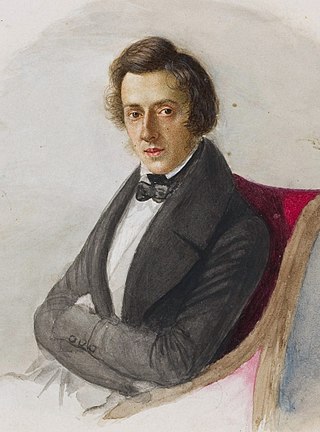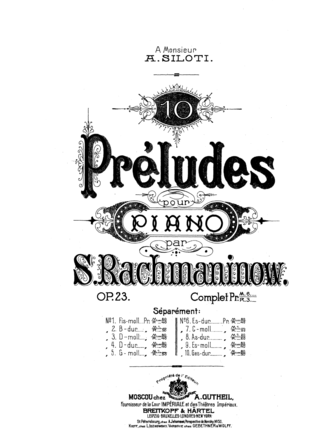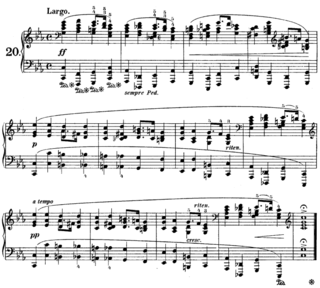
The Prelude in E-Flat Minor, Op. 23 No. 9 is a 1903 composition by Sergei Rachmaninoff. [1] It is part of Rachmaninoff's Ten Preludes, Op. 23, and is one of the most difficult of the set.

The Prelude in E-Flat Minor, Op. 23 No. 9 is a 1903 composition by Sergei Rachmaninoff. [1] It is part of Rachmaninoff's Ten Preludes, Op. 23, and is one of the most difficult of the set.
A double note theme is announced in measures 1–4. The piece then modulates rapidly from bar to bar, passing through: G flat (measure 5); C flat (measure 6); A flat minor (measure 7); and B flat (measure 9). The primary melody returns at measure 11.
In measures 5–10 a number of thirds, sixths, seconds, and fourths make up the right hand melody. The left hand is an arpeggiated figure sporadically interrupted with minor seconds.
A reiteration of A occurs at measure 23.
The theme occurs again, and then at measure 34, a completely new theme appears in the soprano.
A series of descending chromatic sequences begins, and the work draws to a close in measure 50.
| | This section is empty. You can help by adding to it. (July 2010) |

Sergei Vasilyevich Rachmaninoff was a Russian composer, virtuoso pianist, and conductor. Rachmaninoff is widely considered one of the finest pianists of his day and, as a composer, one of the last great representatives of Romanticism in Russian classical music. Early influences of Tchaikovsky, Rimsky-Korsakov, and other Russian composers gave way to a thoroughly personal idiom notable for its song-like melodicism, expressiveness and rich orchestral colours. The piano is featured prominently in Rachmaninoff's compositional output and he made a point of using his skills as a performer to fully explore the expressive and technical possibilities of the instrument.

The Rhapsody on a Theme of Paganini, Op. 43, is a concertante work written by Sergei Rachmaninoff for piano and orchestra, closely resembling a piano concerto, all in a single movement. Rachmaninoff wrote the work at his summer home, the Villa Senar in Switzerland, according to the score, from 3 July to 18 August 1934. Rachmaninoff himself, a noted performer of his own works, played the piano part at the piece's premiere on 7 November 1934, at the Lyric Opera House in Baltimore, Maryland, with the Philadelphia Orchestra conducted by Leopold Stokowski.

Six moments musicaux, Op. 16, is a set of solo piano pieces composed by the Russian composer Sergei Rachmaninoff between October and December 1896. Each Moment musical reproduces a musical form characteristic of a previous musical era. The forms that appear in Rachmaninoff's incarnation are the nocturne, song without words, barcarolle, virtuoso étude, and theme and variations.

The Piano Sonata No. 2 in B♭ minor, Op. 35, is a piano sonata in four movements by Polish composer Frédéric Chopin. Chopin completed the work while living in George Sand's manor in Nohant, some 250 km (160 mi) south of Paris, a year before it was published in 1840. The first of the composer's three mature sonatas, the work is considered to be one of the greatest piano sonatas of the literature.
Prelude in G minor, Op. 23, No. 5, is a piece of music by Sergei Rachmaninoff, completed in 1901. It was included in his Opus 23 set of ten preludes, despite having been written two years earlier than the other nine. Rachmaninoff himself premiered the piece in Moscow on February 10, 1903, along with Preludes No. 1 and 2 from Op. 23.

The Nocturnes, Op. 9 are a set of three nocturnes for solo piano written by Frédéric Chopin between 1831 and 1832, published in 1832, and dedicated to Madame Marie Pleyel. These were Chopin's first published set of nocturnes. The second nocturne of the work is often regarded as Chopin's most famous piece.

Ten Preludes, Op. 23, is a set of ten preludes for solo piano, composed by Sergei Rachmaninoff in 1901 and 1903. This set includes the famous Prelude in G minor.
Lilya Efimovna Zilberstein is a Russian-born German pianist.

The Nocturnes, Op. 55 are a set of two nocturnes for solo piano written by Frédéric Chopin. They are his fifteenth and sixteenth installations in the genre, and were composed between 1842 and 1844, and published in August 1844. Chopin dedicated them to his pupil and admirer Mademoiselle Jane Stirling.

The Prelude in B-Flat Major, Op. 23 No. 2 is a composition by Sergei Rachmaninoff completed and premiered in 1903.

The Prelude in F-sharp minor, Op. 23, No. 1 is a composition by Sergei Rachmaninoff completed and premiered in 1903. It is one of ten preludes composed by Rachmaninoff in 1901 and 1903.

The Prelude in D major, Op. 23 No. 4 is a 1903 composition by Sergei Rachmaninoff. It is part of Rachmaninoff's Ten Preludes, Op. 23.

The Prelude in E-flat Major, Op. 23, No. 6 is a 1903 composition by Sergei Rachmaninoff. It is part of Rachmaninoff's Ten Preludes, Op. 23.

The Prelude in C minor, Op. 23, No. 7 is a 1903 composition by Sergei Rachmaninoff. It is part of Rachmaninoff's Ten Preludes, Op. 23.

The Prelude in A-flat major, Op. 23, No. 8, is a 1903 composition by Sergei Rachmaninoff. It is part of Rachmaninoff's Ten Preludes, Op. 23.

The Prelude in G-Flat Major, Op. 23 No. 10 is a 1903 composition by Sergei Rachmaninoff. It is part of Rachmaninoff's Ten Preludes, Op. 23.

The Prelude Op. 28, No. 20, in C minor by Frédéric Chopin has been dubbed the "Funeral March" by Hans von Bülow but is commonly known as the "Chord Prelude" due to its slow progression of quarter note chords.
Blues, Rags and Stomps, Op. 1, was composed by Robert Boury between 1970-1973. It consists two books, three movements each. Boury composed mostly during his graduate study at the University of Michigan in Ann Arbor. The first set was nicknamed “Varsity Rags”, which Eubie Blake admired and told the audience, “Now that’s ragtime”, after he heard Boury’s performance at the 1971 Toronto ragtime Festival. Book I and II consist of three movements each: I. A Tristan Two-Step, II. Alice Walking, and III. The Rocket’s Red Glare. Book II: I. Eubie’s Blues, II. Stroller in Air, III. I Left My Heart. Boury comments that “A Tristan Two-step” represents his breakaway from modern music and was a way to be accepted as a tonal composer.
Alexander Scriabin's 24 Preludes, Op. 11 is a set of preludes composed in the course of eight years between 1888–96, being also one of Scriabin's first published works with M.P. Belaieff in 1897, in Leipzig, Germany, together with his 12 Études, Op. 8 (1894–95).
The Études-Tableaux, Op. 33, is the first of two sets of piano études composed by Sergei Rachmaninoff. They were intended to be "picture pieces", essentially "musical evocations of external visual stimuli". But Rachmaninoff did not disclose what inspired each one, stating: "I do not believe in the artist that discloses too much of his images. Let [the listener] paint for themselves what it most suggests." However, he willingly shared sources for a few of these études with the Italian composer Ottorino Respighi when Respighi orchestrated them in 1930.